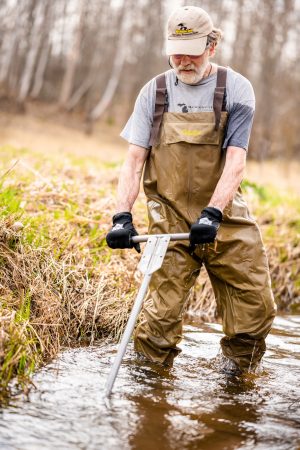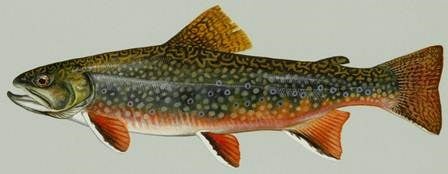Professor Casey Huckins has been studying the ecology of coaster brook trout for nearly 20 years. He started out investigating these migratory fish’s population ecology and life history. His research now focuses on analyzing the movement patterns of coaster brook trout due to human impact on the watershed. He is also focusing on ways to restore them and the habitat they need to spawn. Recently, with funding from the Michigan Departments of Environment, Great Lakes and Energy (EGLE) and the Department of Natural Resources, his lab has been actively restoring its critical habitat. “Human actions have turned these iconic heritage species of Lake Superior into a conservation concern by overharvesting them and disturbing their habitat,” Huckins explains.
His team is actively studying the two coaster brook trout populations still known to exist along the south-central shore of Lake Superior.
These migratory coaster brook trout live in Lake Superior. However, they return to their rivers of origin to breed in the same spots where they were spawned. Due to disturbances in the watersheds, like logging and road use, the spawning habitat of these creatures has been buried. This has altered the critical dynamic of erosion and sedimentation, leading to a buildup of fine sand. The sand present here is responsible for covering larger sediment particles like cobbles and pebbles. Cobbles are small rocks that have been rounded by water flow. These pebbles serve as the spawning habitat and also as the home for the brook trout’s food and aquatic insects.
With his recent state funding, Huckins says his goal is to restore the critical spawning habitat. He will do this by removing excess sand and studying the impacts on the habitat and the brook trout population. His team has installed in-stream sand collectors that passively collect sand as it flows over them. The researchers then routinely operate pumps to move the sand out of the floodplain.
Huckins’ team is now investigating whether the community of stream insects that are key food items for the brook trout also increases in abundance, diversity, and community structure. He hopes to see a site with natural, free-flowing cobble-based cold-water habitat. Huckins found this at the site when he started studying it with his graduate students nearly two decades ago.
His next goal is to acquire additional funding to automate the sand collectors to operate independently. Huckins’ goal is to eliminate the need for researchers to manually pump sand at the site, saving them time and fuel expenses. The team is currently expanding their efforts to implement this system in various streams and rivers. Their equipment is being utilized to rehabilitate other waterways that have suffered from erosion due to flooding, land use, or other factors that cause sand to flow downstream. As our climate changes, we expect to see more extreme events that will have outcomes we need to address to restore and maintain these critical aquatic ecosystems.
This blog post initially appeared in the Fall 2022 Biological Sciences Newsletter. Read this article and others like it today.

